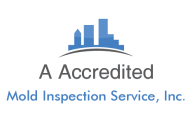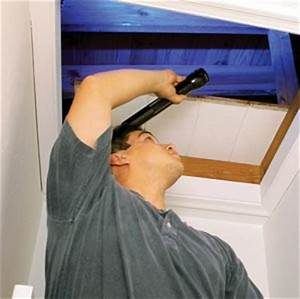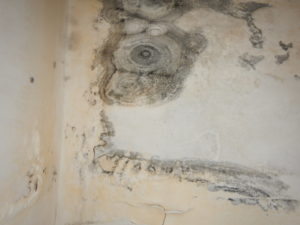Toxic Black Mold in a Petri Dish or Home Mold Test Kit What Does It look Like?
The most common mold people want to learn to identify in home mold test kits is Toxic Black Mold, also known as Toxic Mold, Black Mold, or Stachybotrys. Its scientific name is Stachybotrys chartarum. Please note in this article we are discussing the appearance of Toxic Black Mold in a Petri Dish.
In the below photos you will see what Toxic Mold in petri dish or home mold test kit look like.
For a discussion on what it looks like on walls in a water damaged home click here.
If you are looking for a mold inspector in South Florida visit our homepage.
Photos of What Toxic Black Mold Looks Like in A Petri Dish
Below are pictures of toxic black mold in petri dishes. The colonies of mold all started out fibrous and white like circular patches of cotton.
Next, they start to turn black in the centers. In several of the below images you can see the black centers. The black centers might have a hint of greenish or grey.
The black centers will both darken and expand to eventually cover the entire colonies surfaces till the mold is all dark black from center to edge.
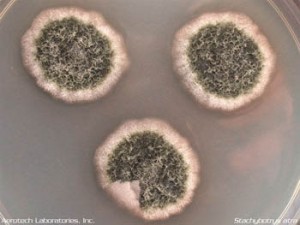
Toxic black mold in a petri dish or home mold test kit. It started out white, next it started to turn black in the center. Next the black center will expand to eventually cover the entire colonies surfaces. Such an evolution of growth may take a week or a few weeks.
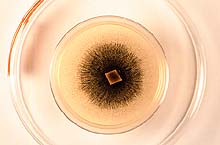
Mature toxic mold in a home mold test kit or petri dish has turned completely black. In this petri dish mold is growing on Potato Dextrose Agar.
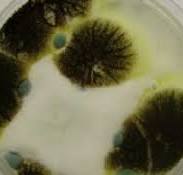
Photo of mature Stachybotrys in petri dish.
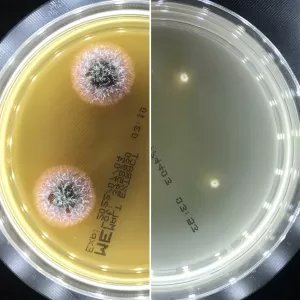
Toxic black mold in a home mold test kit or Stachybotrys in a home mold test kit. Incubated at 77F or 25C for 7 days. The two colonies on the left are growing on a nutritious gelatinous growth media called Malt Extract Agar (MEA) so they grew large and fast and produced black spores in the center. If you are using a home mold test kit this is the media it is likely provided with. The two colonies on the right are growing in DG 18. They grow slowly and poorly in DG 18 media and thus are very small. Because they have produced no spores in this media they are still white.
More Photos of What Toxic Mold Looks Like in A Petri Dish
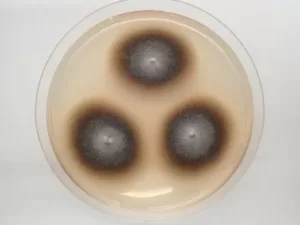
Additional image of what black mold looks like in a mold test kit or petri dish.
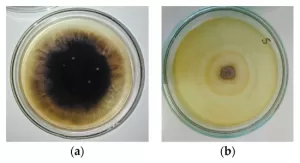
Here we see photos of what very mature black mold looks like in a petri dish. The two test kit petri dishes show black mold after three months of growth in different media.
Additional Photo of What Black Mold Looks Like in A Home Petri Dish.
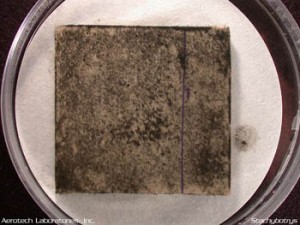
Photo of toxic mold in a petri dish. Above is a photo showing what mature toxic black mold looks like growing in a petri dish or test kit. No more green or white, just black. In this image the lab is using a square sheet of paper as a food source. In most home dishes the mold will appear rounder because most home test kit dishes do not use square paper.
Clarification on the Appearance of Toxic Mold In Home Test Kits
So why is a mold we call toxic black mold sometimes fuzzy and white like cotton and sometimes even displaying hints of greenish, or gray?
The reason is because this is how the mold will appear in the petri dish when it is still young and only forming light-colored microscopic fibers called mycelium.
The reason for the color change is that the young mold fibers start out white. After some time, the young white fuzzy mold fibers will mature and start to form black spores. The black spores are what gives the mold it’s black color.
You will not see the tiny black spores with your necked eye. When thousands or millions of dark black mold spores have formed on the mold test kit, they will cumulatively give the mold it’s characteristic black appearance.
The color change to black will start in the center and spread slowly to the edges. The reason is because the center is older, so the center produces spores first.
Problems With Growing Toxic Mold in Home Mold Test kits.
If you find what looks like black toxic mold in home mold test kits do not panic and make yourself sick over mold fears. This happens to a lot of people and my heart breaks for them. I know because I have been doing mold inspections in South Florida for decades and have seen it before. If you overreact then mold testing consultants, mold remediators, and even some holistic doctors will see it and take advantage of your fears.
Do Not Let a Mold Remediator rip your house apart looking for toxic mold because you saw what you believe is Toxic Black Mold in a Petri Dish. Many dark colored molds are common even in healthy non-problematic homes. Just because you have black mold in a petri dish, or any mold in a petri dish does not guarantee a mold problem.
Often what petri dishes are indicating when any color mold grows in them are normal background levels of spores in your home. That’s right! Often what petri dishes are indicating even when black mold grows in them are normal background levels of spores in your home. Most of the time the black mold in a petri dish is Cladosporium mold. And in most cases this is completely normal and expected. Almost all home mold test kits show some type of white, brown, black, or green mold growth. So, what is the solution? Read on and find out.
If In Doubt Hire a Qualified Mold Inspector
If you suspect a home mold problem have a professional non-bias mold inspector with good reviews to do a detailed mold and moisture survey of your home. Don’t hire someone who does mold inspections and mold removal. Hire someone who specializes in mold inspections and testing only.
If you live outside of Florida find an inspector in your area here.
And If you live in South Florida find an inspector in your area here.
No home mold test kit can compete with a true mold inspection by a licensed and certified mold inspector. A mold inspector is more expensive but he or she will take samples using a spore trap and pump. Such pumps allow for direct examination of the spores under the microscope regardless of growth rate. Also, mold inspector’s samples give a count of spores so you know if the level are normal levels of mold or are elevated levels in your home.
Most importantly he or she should look for your mold problems source, and hopefully find it’s causes, and make recommendations based on years of experience. You do not get these services with any home test kit.
Curious about what toxic black mold looks like in a home? Check the below image out. or Click here.
Close up of Toxic Black Mold on a wall in West Palm Beach Florida. This image was taken by our mold tester during mold inspections and testing in West Palm.
References:
Field Guide for the Determination of Biological Contaminates in Environmental Samples.
An AIHA Biosafty Guide
American Industrial Hygiene Association
1996.
Identifying Filamentous Fungi a Clinical Laboratory Handbook by Guy St-Germaine and Richard Summerbell.
Star Publishing Company 1996.
Page 196.
Information provided by:
A Accredited Mold Inspection Service. Providing mold inspections and testing since 2003.
1-888-381-6651
